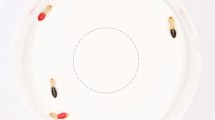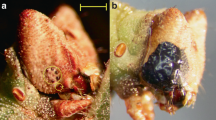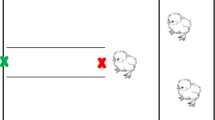Abstract
ANIMAL signals are often 'multicomponent'1–3, consisting of displays with several parts to allow exploitation of different senses. An example is the courtship display of the peacock, which combines dashing movements with a noisy, shimmering show of his train feathers4. Yet the significance of multicomponent signalling is unknown. As a model multicomponent signalling system, we investigated the warning signals of toxic insects, which often combine pyrazine odours with conspicuous coloration such as yellow or red5–7. Here we demonstrate, in prey choice experiments with birds, that pyrazine interacts with red and yellow to induce strong aversions to these aposematic colours that are not shown in the absence of the odour. Pyrazine is shown neither to be inherently aversive, nor to induce aversion to a non-aposematic colour, green. To our knowledge, this study provides the first evidence that the function of multicomponent signals can lie in hidden psychological responses produced by the interaction of their components.
This is a preview of subscription content, access via your institution
Access options
Subscribe to this journal
Receive 51 print issues and online access
$199.00 per year
only $3.90 per issue
Buy this article
- Purchase on Springer Link
- Instant access to full article PDF
Prices may be subject to local taxes which are calculated during checkout
Similar content being viewed by others
References
Moller, A. P. & Pomiankowski, A. Behav. Ecol. Sociobiol. 32, 167–176 (1993).
Johnstone, R. A. Phil. Trans. R. Soc. Lond. 351, 329–338 (1996).
Guilford, T. C. & Dawkins, M. S. Anim. Behav. 42, 1–14 (1991).
Petrie, M. Nature 371, 598–599 (1994).
Moore, B. P., Brown, W. V. & Rothschild, M. Chemoecology 1, 43–51 (1990).
Guilford, T. C., Nicol, C. J., Rothschild, M. & Moore, B. P. Biol. J. Linn. Soc. 31, 113–128 (1987).
Marples, N. M. & Roper, T. J. Anim. Behav. 51, 1417–1424 (1996).
Gittleman, J. L. & Harvey, P. H. Nature 286, 149–150 (1980).
Schuler, W. & Roper, T. J. Adv. Stud. Behav. 21, 111–146 (1992).
Rothschild, M. Trans. R. Entomol. Soc. Lond. 113, 101–121 (1961).
Author information
Authors and Affiliations
Rights and permissions
About this article
Cite this article
Rowe, C., Guilford, T. Hidden colour aversions in domestic chicks triggered by pyrazine odours of insect warning displays. Nature 383, 520–522 (1996). https://doi.org/10.1038/383520a0
Received:
Accepted:
Issue Date:
DOI: https://doi.org/10.1038/383520a0
This article is cited by
-
Male nuptial display colour and vocalisation appear to signal independent information in the whirring tree frog
Behavioral Ecology and Sociobiology (2023)
-
In paired preference tests, domestic chicks innately choose the colour green over red, and the shape of a frog over a sphere when both stimuli are green
Animal Cognition (2023)
-
Increasingly cautious sampling, not the black colouration of unpalatable prey, is used by fish in avoidance learning
Animal Cognition (2023)
-
Pattern contrast influences wariness in naïve predators towards aposematic patterns
Scientific Reports (2020)
-
Hemipteran defensive odors trigger predictable color biases in jumping spider predators
Scientific Reports (2020)
Comments
By submitting a comment you agree to abide by our Terms and Community Guidelines. If you find something abusive or that does not comply with our terms or guidelines please flag it as inappropriate.



